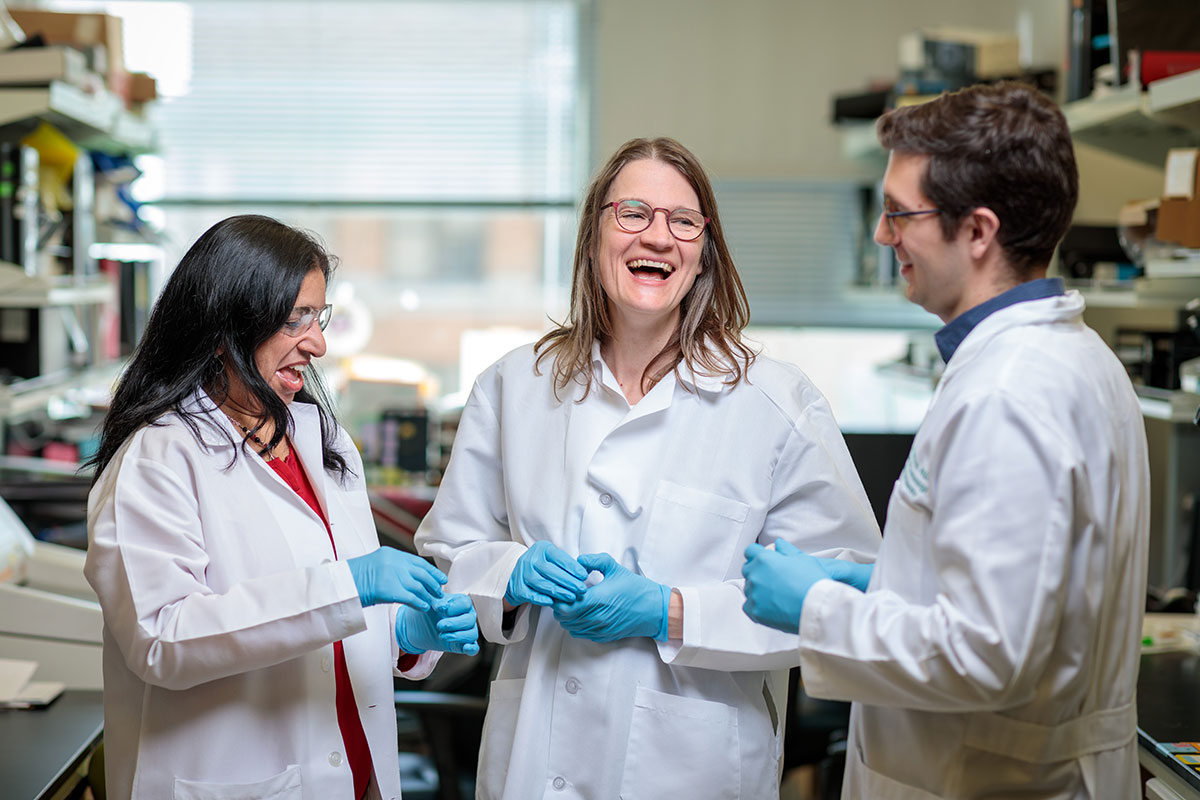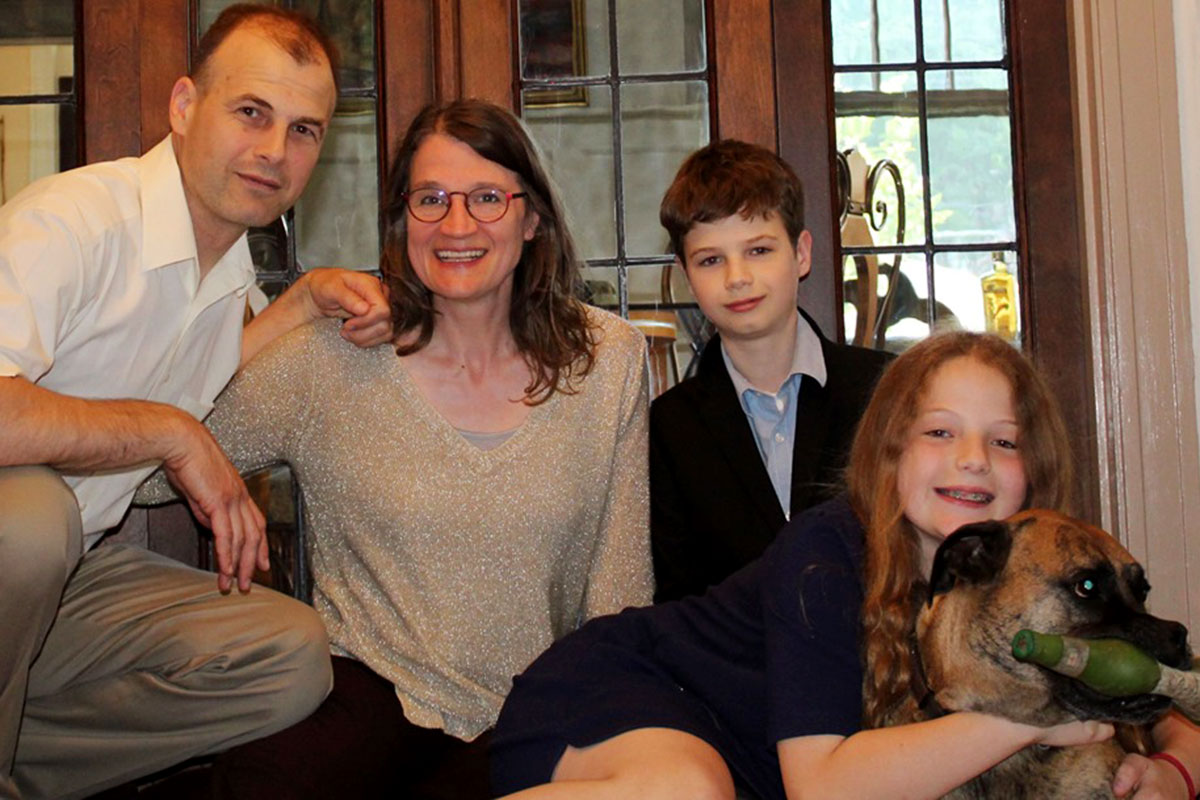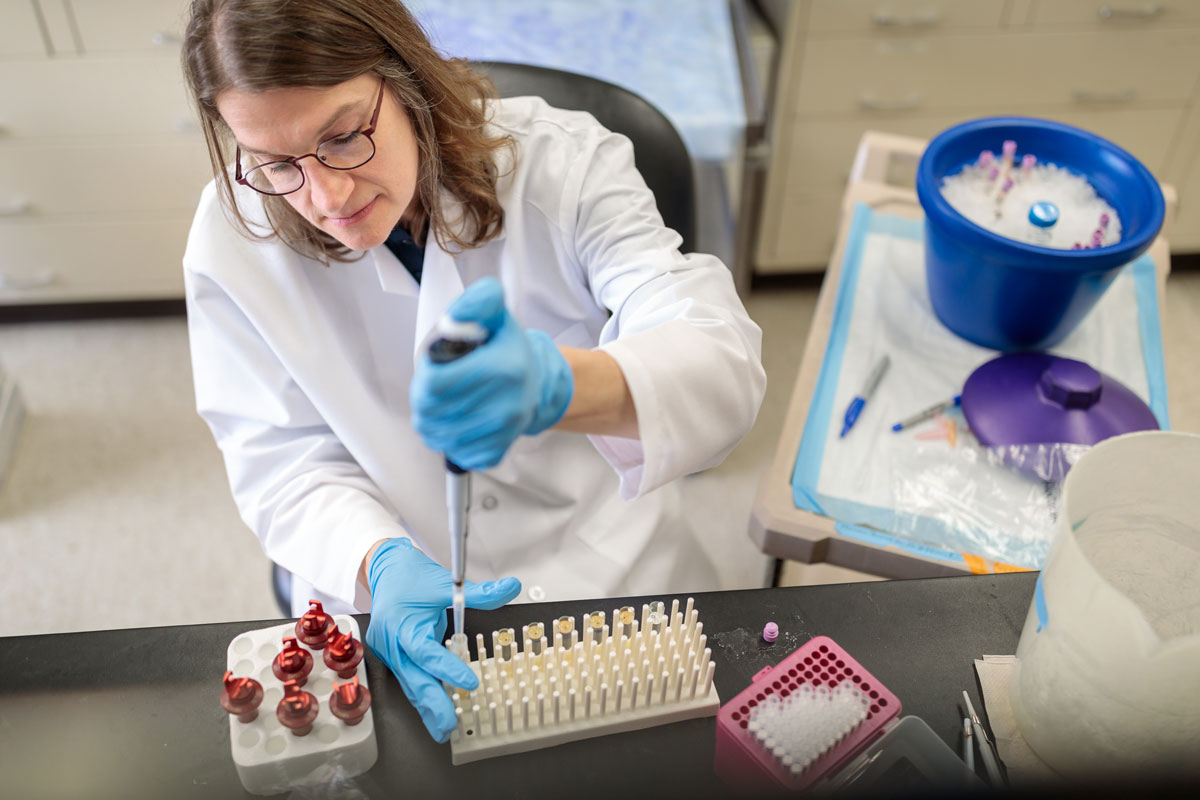
A few years ago, as immunologist Gwendalyn Randolph, PhD, and postdoctoral researcher Li-Hao “Paul” Huang, PhD, hashed out a research plan, the two realized they had a problem. They were studying inflammatory bowel disease (IBD), and they needed human participants for a study looking at how fat travels from the intestine to the blood. But they had never done a human study that required more of participants than donating a small amount of blood. Worse, they didn’t have a local clinical collaborator since Randolph, the Emil R. Unanue Distinguished Professor of Immunology at Washington University School of Medicine in St. Louis, had just recently arrived in St. Louis from Icahn School of Medicine at Mount Sinai in New York City.
Randolph and Huang started designing a study to be conducted at Mount Sinai, where Randolph still had many collaborators. But to do so, they needed to figure out how the fats would be delivered to participants and brought back to St. Louis for analysis.
“First, we were concerned with formulating a fat-rich meal that would be palatable and could be made reproducibly by our colleagues in New York,” Huang said. “We went to Gwen’s house, and we prepared a milkshake with ice cream and whole milk and the other ingredients needed for the study – including fat molecules that could be traced in the laboratory – and we drank it.”
The taste test was successful, but luckily, it turned out to be unnecessary. Not long after, Washington University gastroenterologist Matthew Ciorba, MD, approached Randolph and suggested a collaboration. And soon, other School of Medicine faculty members — gastroenterologist Parakkal Deepak, MBBS, and nutrition experts Bettina Mittendorfer, PhD, Bruce Patterson, PhD, and W. Todd Cade, PhD — signed on as well. Together, they redesigned the study to leverage Washington University’s prowess in translation medicine. Randolph was only too happy to leave milkshake formulation to the true experts.
The study is nearing completion. It represents a remarkable shift in focus for Randolph, who began her career studying how immune cells travel around the body.
“She’s just a fantastic scientist,” said Paul Allen, PhD, the Robert L. Kroc Professor of Pathology and Immunology and a collaborator of Randolph’s. “She used to work on innate immune cells, but then she blossomed out into cardiovascular disease, lipid metabolism, the gut. It’s just amazing how she finds these connections between different fields.”
Randolph has a long track record of breaking down scientific silos. An immunologist by training, she made a name for herself in cardiovascular and inflammation research by asking questions no one else had thought to ask.
“For her, it’s like solving mysteries,” said Melody Swartz, PhD, a professor of molecular engineering at the University of Chicago and a longtime collaborator of Randolph’s. “She just really cares about science. She is not interested in awards or being the first to publish; she really and truly only cares about figuring out what’s going on.”

An accidental scientist
If the stars had aligned just a bit differently, Randolph, who is also a professor of medicine, might never have become a scientist at all. Raised on a maize and cotton farm outside the small town of Hart in the Texas Panhandle, she grew up hoeing weeds and helping with the harvest.
As a teenager, she exhibited a talent for sewing and design that won her awards and trips to New York and Los Angeles. But when she started talking about moving east to study textiles after high school, her parents – both descended from generations of Southern farmers – hesitated. So instead, she accepted a basketball scholarship to Wayland Baptist University in nearby Plainview, Texas, and enrolled in pre-med courses.
“I thought I was going to be a doctor, but in the spring of my first year, I fell in love with histology,” Randolph recalled, referring to the microscopic structure of tissues. “I can remember sitting in a laundromat, doing my laundry, reading this book on how white blood cells leave the bloodstream and go into tissues, and I was just fascinated. It was very historical, and I remember wondering if anyone was still studying that stuff.”
Not many people were, it turned out. Immunologists love to study the immune system’s lymph nodes, where cells that have encountered infectious organisms or signs of injury go to alert other cells about the danger in their midst. But immunologists don’t tend to spare much thought for the journey immune cells take on their way to the lymph nodes. Once she had the scientific training, Randolph returned to the question that had first piqued her interest – what happens en route to the lymph nodes – and began to investigate. She was fascinated to learn that lymphatic vessels that connect lymph nodes are far from an inert network of tubing. The vessels dilate or constrict to slow or speed the rate of travel. She showed that the constricting lymphatic vessels leak many signaling molecules into the surrounding tissue, and these signals are captured by other immune cells that, in turn, respond to help regulate immunity. All these functions add up to a pivotal role for the lymphatics in shaping the immune response.
“Everyone was throwing away the fatty tissue that is outside of lymph nodes because it’s boring,” Randolph said. “But fat is what links all the organs to the various lymph nodes that collect drainage from our tissues, and it turns out all kinds of things are happening in the fat.”
That brief textbook passage on histology eventually led Randolph to break down the wall separating lymphatic biology and immunology, and show that how cells and molecules get places is just as important as where they’re going.
Blazing a trail in New York
After two years at Wayland Baptist, Randolph moved to Pennsylvania, where she completed her undergrad studies at Temple University. From there, she moved to the State University of New York, Stony Brook, for graduate school, and then to Rockefeller University and Weill Cornell Medicine for postdoctoral studies.
In New York, while a postdoc at Rockefeller and Weill Cornell, Randolph worked closely with Ralph Steinman, MD, who went on to win the Nobel Prize in Physiology or Medicine in 2011 for his discovery of the dendritic cell – the cell type that orchestrates and conducts the immune response.
In collaboration with Steinman, Randolph published a paper in Science in 1998 showing that dendritic cells mature from a different immune cell type – and that dendritic cells are compelled to migrate to lymph nodes. As part of the study, Randolph grew immune cells in collagen matrices below a layer of cells that line the inner surface of blood vessels. The immune cells passed through the blood vessel cells and migrated upward, toward the rim of the wells. They had presumably climbed through the blood vessel-cell layer in search of lymphatic vessels that would, in a living animal, take them to the lymph nodes. The strong propensity of dendritic cells to migrate to lymph nodes, even when lymph nodes were not part of the experimental setup, fueled her research on lymphatic vessels.
Randolph met her future husband, Hermann Kyrychenko, at an art gallery while on vacation in Prague, and within a year, he moved to New York to be with her. Today, they have two children: Anton, 14, and Athena, 11.

A Ukrainian national by birth who has worked as a translator, a paramedic, an art gallery docent and a martial arts instructor, Kyrychenko did much of the child-raising while Randolph established a lab at Mt. Sinai and started exploring the relationship between the lymphatics and other systems of the body, notably the cardiovascular system.
Immune cells known as macrophages help keep blood flowing smoothly by eating up the cholesterol that sometimes collects inside blood vessels. Randolph hypothesized that, after consuming cholesterol, macrophages migrate from the bloodstream through the lymphatics to dispose of the cholesterol, and that problems with the lymphatics could cause the sticky substance to build up, raising the risk of heart attack. This hypothesis proved untrue, but the process of investigating it unveiled other key observations on macrophages, including how much macrophages vary from organ to organ.
“What I really like about Gwen is that she goes where the data take her,” said Robert Gropler, MD, a professor of radiology who works with Randolph to develop new positron emission tomography (PET) imaging probes designed to detect signs of inflammation and immunity. “She maintains an open mind, and because of that, she’s a highly innovative scientist. Her real strength is the breadth and depth of her knowledge. She knows not only her own field but other fields well enough to see how they could benefit from collaboration. She’s just a really incredible resource for the university.”
Along with her willingness to pursue novel scientific ideas, Randolph has earned a reputation for being willing to stand up for what she believes, especially on issues affecting women and people who aren’t in positions of power. At Mount Sinai, she helped establish a lactation room after several postdocs in her lab and neighboring labs gave birth, and she realized they had nowhere clean and private to pump milk. She once challenged the dean of the School of Medicine at Mount Sinai to a basketball game – both loved the sport – to settle a dispute over the school’s policy of taking a cut of postdocs’ career award funding to beef up indirect cost recovery from those awards. The game never happened, but a compromise for the source of the indirect costs was reached, with the departments rather than the investigators covering the required amount. At Washington University, she has continued to voice concerns that touch on social justice.
“She will never allow something wrong to happen in front of her eyes without fighting against it,” said Miriam Merad, MD, PhD, an immunologist at Mt. Sinai who worked with Randolph for many years. “It has sometimes been to her detriment to be so vocal. But Gwen will always fight for the cause she believes in.”
Finding a scientific home in the Midwest
In 2011, when word began to spread at Mt. Sinai that her department was closing, Randolph took a job at Washington University. She resettled her family in Clayton, partly because it was close enough for her to bike across Forest Park to work every day.
“I might be the only one from the Panhandle of Texas who ever existed who doesn’t like cars,” Randolph said. “We have a car, but I refuse to drive to work.”
In Clayton, she cultivates a varied and thriving vegetable and herb garden. When Huang dropped by her home one afternoon to pick up some reagents he needed in the lab, Randolph treated him to homemade vegetable pizza, marinated cucumbers, basil ice cream – “That was a bit weird,” Huang said – and cake with blackberry sauce. Most of the produce for the meal had been harvested from her own backyard.
Just before Randolph moved to St. Louis, a chance conversation at Mount Sinai changed the course of her research.
“My graduate student was presenting her research on fat and lymphatics, and one of my colleagues turned to me and joked, ‘There is only one person who is interested in fat and lymphatics other than you: Jean-Frederic Colombel,’” Randolph said. “So I called him up.”
Colombel turned out to be a gastroenterologist who specializes in Crohn’s disease. He introduced Randolph to the peculiar “creeping fat” that grows up around the intestine near sites of damage in IBD. The fat is associated with strictures in the intestine that can cause bowel obstruction and necessitate emergency surgery. Colombel thought the fat was not just a curiosity but was contributing to the disease. Intrigued, Randolph began collaborating with Colombel to investigate the role of fat and lymphatics in IBD.
“I make decisions, and I move forward, and I don’t spend a lot of time thinking, ‘Does it make sense to take on this risk?’” Randolph said. “Some doors close, and I open other doors and move forward.”
In 2015, she received a prestigious Pioneer Award from the National Institutes of Health (NIH) to study how gut inflammation affects the lymphatic vessels near the intestine. She suspects that inflammatory cells release proteins that cause the vessels to constrict, impeding the flow of immune cells and proteins and contributing to a dysfunctional inflammatory response.
She also suspects that the fat itself is part of the problem. Some of the fat leaves the intestines and travels through the lymphatics to the bloodstream, converting into fatty acids along the way. Some fatty acids are highly inflammatory, so roaming fat could be contributing to the destructive inflammation of the disease.
Although the work is still in its early stages, it could transform our understanding of how IBD develops and progresses, and lead to novel strategies for treating the disease.
“She is a completely independent thinker, an innovator,” Merad said. “Nothing surprises me coming from Gwen. If you told me she has become an astronaut, I would not be surprised. She dares and never looks back.”

Source: Read Full Article